Table of Contents
Table of Contents
Imagine you're playing a game of chess, but instead of reacting to your opponent's moves, you can see five moves ahead and plan your strategy accordingly. That's the power of proactive network monitoring. Instead of waiting for issues to arise and reacting to them, you can stay several steps ahead and keep your network running smoothly.
In this post, we'll explore the art of proactive network monitoring and how it can help you stay ahead of the game. By taking a proactive approach to monitoring your network, you can identify potential issues before they cause disruptions, optimize performance, and keep your network healthy and secure. Let's dive in!
As a little recap to make sure we’re all on the same page, here is what network monitoring is in our books.
Network monitoring or network performance monitoring is the process of monitoring and measuring collective network metrics to define the quality of services offered by a network, primarily measured from an end-user perspective.
Simply put, network monitoring refers to measures of service quality of a network, as seen by the customer or end-user.
When it comes to network monitoring, remember that:
- Network Performance is something that can be measured. You can’t fix what you can’t measure - and you can definitely measure network performance with network metrics like packet loss, jitter, throughput, and more!
- Network Quality refers to the quality of the network connection and is based on factors like: is the connection stable and fast or, slow, laggy, etc?
- The End-User Perspective is what defines good or bad performance. Good network performance is the network's ability to perform to the user’s expectations.
In previous articles, we always talk about how there are 3 common network monitoring use cases that everyone should be aware of. There are many benefits and reasons to monitor network performance, but generally, post people turn to network performance monitoring for 3 things:
- Network Assessment
- Network Troubleshooting
- Continuous Monitoring
When you’re thinking about why continuous or proactive network monitoring is important, remember that: Proactively leads to productivity. Because essentially, continuous network monitoring is also proactive network monitoring.
The key to optimizing network performance and finding network problems before they affect end-users is to always be:
- Network Monitoring
- Network Testing
- Network Troubleshooting
Proactive network monitoring is a type of network monitoring that is designed to identify and resolve issues before they cause problems or disruptions. Unlike reactive network monitoring, which focuses on detecting and responding to issues after they have already occurred, proactive network monitoring takes a preventative approach by continuously monitoring the network for potential issues and taking action to address them before they cause downtime or performance issues.
Proactive network monitoring typically involves the use of specialized tools and software that collect and analyze data from various points in the network, such as routers, switches, servers, and endpoints. IT teams can use this data to identify potential issues and set performance thresholds and alerts to notify them when performance deviates from expected levels.
The benefits of proactive network monitoring include improved network performance, increased network availability, enhanced security, and reduced downtime. By identifying and resolving issues before they cause problems, IT teams can improve the overall health and performance of the network, reduce the risk of security breaches, and ensure that users have a positive experience accessing network resources.
Overall, proactive network monitoring is an essential component of a comprehensive network monitoring strategy, and can help organizations maintain a stable and secure network infrastructure while minimizing disruptions and downtime.
Nobody likes a slow network or a surprise outage, but with proactive network monitoring, you can stay ahead of the game and avoid these headaches altogether. By detecting issues early, optimizing performance, and enhancing security, proactive network monitoring can help you keep your network healthy and running smoothly.
Let's explore some of the benefits in more detail:
- Early detection and resolution of issues: Proactive monitoring, (especially proactive real-time network monitoring) allows you to identify and resolve issues before they cause disruptions or downtime. By detecting potential issues early, you can take action to prevent them from becoming major problems.
- Improved network performance: Proactive monitoring allows you to identify and address performance issues before they impact users. By optimizing network performance, you can ensure that users have a positive experience accessing network resources.
- Enhanced network security: Proactive monitoring can help you identify and address security vulnerabilities before they are exploited by attackers. By staying ahead of potential threats, you can reduce the risk of data breaches and other security incidents.
- Reduced downtime: By identifying and resolving issues proactively, you can minimize downtime and keep your network up and running. This can help you avoid the costs and reputational damage associated with network outages.
- Cost savings: Proactive monitoring can help you identify and address issues before they become major problems, reducing the need for expensive emergency repairs and minimizing the impact of downtime.
Overall, proactive network monitoring is an essential component of a comprehensive network monitoring strategy. By staying ahead of potential issues, optimizing performance, and enhancing security, you can ensure that your network is healthy and running smoothly.
Ready to level up your network monitoring game? Try Obkio! Our platform makes proactive network monitoring a breeze, so you can stay ahead of potential issues and keep your network healthy and secure.
And let's take your network to the next level!

- 14-day free trial of all premium features
- Deploy in just 10 minutes
- Monitor performance in all key network locations
- Measure real-time network metrics
- Identify and troubleshoot live network problems

So how can you be proactive while monitoring network performance, well, you continuously monitor network performance.
Continuous network monitoring is the process of monitoring network systems, devices, and traffic in real-time to identify and resolve issues as they occur. This is done using specialized software and tools that collect and analyze data from various points in the network, such as routers, switches, servers, and endpoints.
The goal of continuous network monitoring is to provide a comprehensive view of network activity and performance, allowing IT teams to identify potential issues before they become major problems. This proactive approach helps to minimize downtime, optimize network performance, and enhance network security.
Continuous network monitoring typically involves monitoring key performance indicators (KPIs) such as network latency, bandwidth usage, packet loss, and uptime. IT teams can use this data to identify trends, set performance benchmarks, and create alerts to notify them of any issues that require attention.
There are several techniques for proactive network monitoring that organizations can use to stay ahead of potential issues and keep their networks healthy and running smoothly. Here are some of the most effective techniques:
- Performance Monitoring: This technique involves monitoring various performance metrics, such as bandwidth usage, latency, packet loss, and jitter. IT teams can use this data to identify potential performance issues and optimize network performance.
- Synthetic Network Monitoring: This technique involves simulating network traffic and testing network performance from various locations and devices to proactively identify potential issues. This technique allows IT teams to test network performance under different conditions and ensure that critical network resources are always available.
- Security Monitoring: This technique involves monitoring the network for potential security threats, such as malware infections, unauthorized access attempts, and data breaches. IT teams can use this data to identify and address security vulnerabilities before they are exploited by attackers.
- Log Analysis: This technique involves analyzing log data from network devices and applications to identify potential issues and troubleshoot problems. IT teams can use log analysis to identify patterns and trends, detect anomalies, and pinpoint the root cause of issues.
- Configuration Management: This technique involves managing and monitoring network device configurations to ensure that they are optimized for performance and security. IT teams can use configuration management to identify potential configuration issues and ensure that devices are configured consistently and correctly.
- User Experience Monitoring: This technique involves monitoring the end-user experience of accessing network resources, such as web applications or cloud services. IT teams can use user experience monitoring to identify potential performance issues and ensure that users have a positive experience accessing network resources.
Overall, by using a combination of these proactive monitoring techniques, organizations can stay ahead of potential issues and keep their networks healthy, secure, and running smoothly.
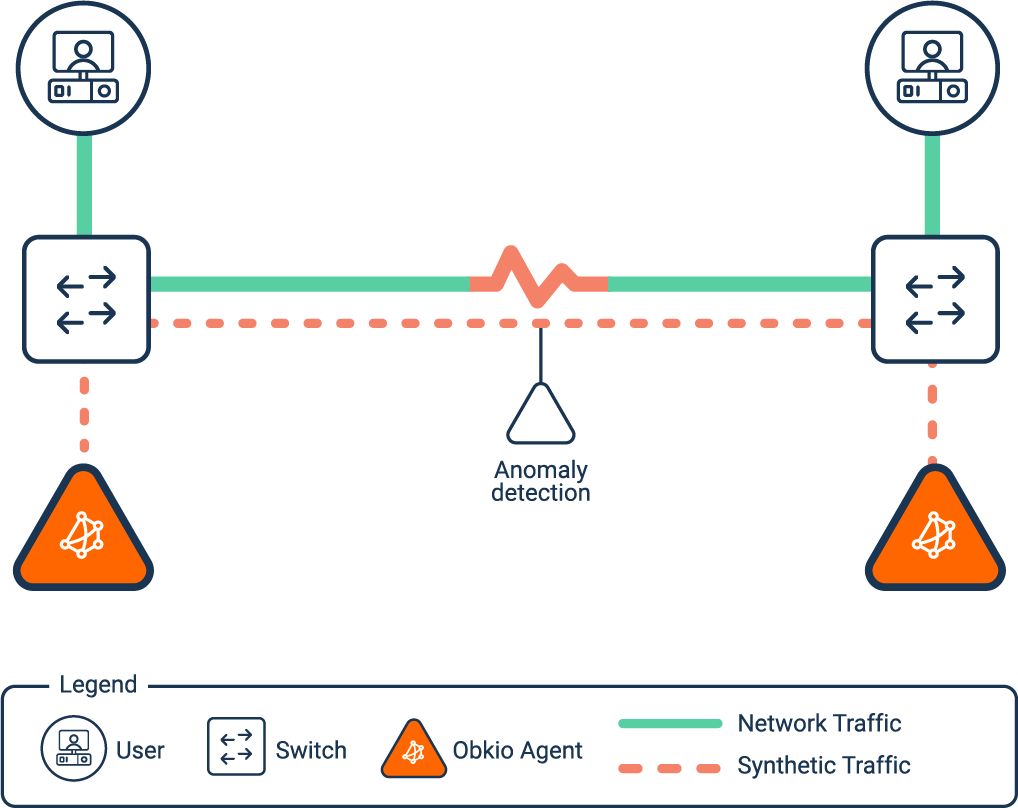
Seeing as proactive network monitoring requires the monitoring to be, well, proactive, it’s not easy to do so manually unless it’s your one and only job. Even then, it’s hard to get the kind of granularity you need on network performance if you try to do it manually.
That’s why we always recommend monitoring network performance using a synthetic network performance monitoring tool like Obkio Network Performance Monitoring software.
Obkio is a simple Synthetic Network Performance Monitoring software that continuously monitors end-to-end performance of your network and core business applications to identify network issues, collect data on network performance, and improve the end-user experience!
This tool becomes a permanent part of your IT solution, and essentially acts like your network administrator. You don’t need to tell a network performance monitoring software when to monitor network performance, because it’ll always be running in the background and let you know when something isn’t right.

To proactively monitor network performance in all your network locations, you need man-power - you need Network Monitoring Agents. This Agents continuously measure network performance in key network locations like offices, data centers and clouds using synthetic traffic to proactively identify network issues before they even affect end-users.
The Monitoring Agents exchange traffic continuously from all network locations - which is key here! For your initial setup, we recommend deploying:
- Local Agents: Installed in the targeted office location experiencing network performance issues. There are several Agent types available (all with the same features), and they can be installed on MacOS, Windows, Linux and more.
- Public Monitoring Agent: Which are deployed over the Internet and managed by Obkio. They compare performance up to the Internet and quickly identify if the network issue is global or specific to the destination. This will be great information for later in the troubleshooting process. You can use an AWS or Google Cloud Agent.
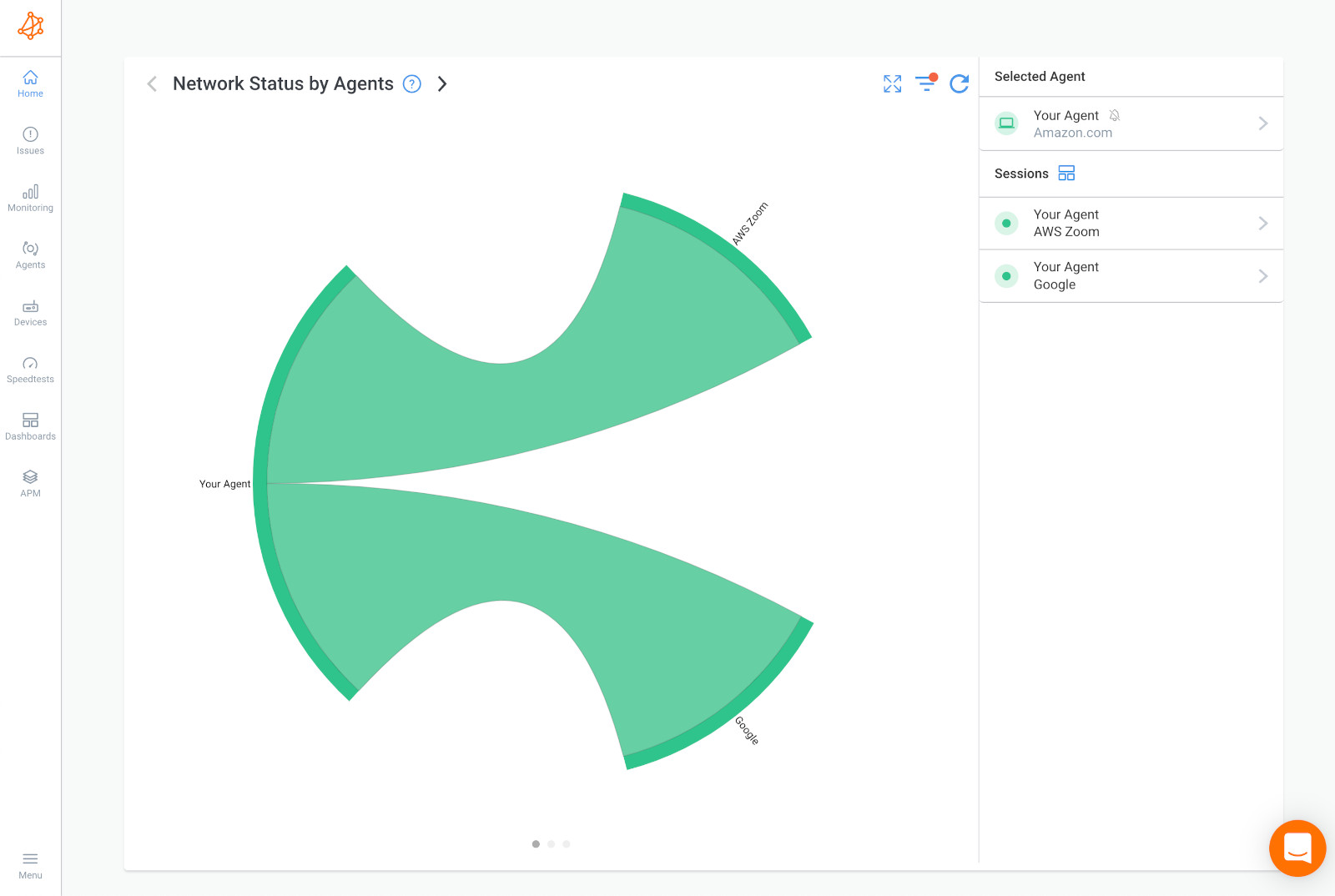
Obkio continuously monitors network performance using synthetic traffic for a Synthetic Monitoring approach that stimulated the end-user experience without capturing real-user traffic.
Network Monitoring Agents exchange UDP traffic to monitor network performance between each pair of Agents. This light traffic is non-intrusive and very secure, and doesn't require any packet capture, which ensures that it respects the users' privacy and doesn't require changes to device configurations.
For example: You can simulate a user accessing a web application from different locations around the world to ensure that the application is performing well and that users have a positive experience. This technique can also be used to simulate traffic during peak network usage periods to ensure that the network can handle high traffic loads.


Obkio’s monitors synthetic traffic every 500 ms to measure network performance in your network twice a second. Compared to other solutions, Obkio’s Network Performance Monitor will continuously monitor network performance instead of executing periodic checks at various intervals. This is key to quickly identifying intermittent network issues that cause slowness in networks.
Another aspect of this is measuring network metrics in real-time. When it comes to proactive network monitoring, there are several key network metrics that you should measure to stay ahead of potential issues and ensure optimal network performance. Here are some of the most important network metrics to monitor:
- Bandwidth utilization: This metric measures the amount of network bandwidth that is being used and can help you identify potential bottlenecks or WAN or LAN congestion.
- Latency: Latency is the time it takes for data to travel from one point in the network to another and can help you identify potential network performance issues.
- Packet loss: The Packet Loss metric measures the number of packets that are lost or dropped during transmission and can help you identify potential network congestion or reliability issues.
- Jitter: Jitter the variation in latency over time and can help you identify potential performance issues that may impact real-time applications such as VoIP or video conferencing. VoIP jitter is especillay an issue.
- Network Availability: This metric measures the percentage of time that network resources are available and can help you identify potential downtime or reliability issues.
- Error rate: This metric measures the number of errors that occur during transmission and can help you identify potential reliability or performance issues.
- Throughput: Throughput the amount of data that is transmitted over the network within a certain time period and can help you identify potential bottlenecks or capacity issues.
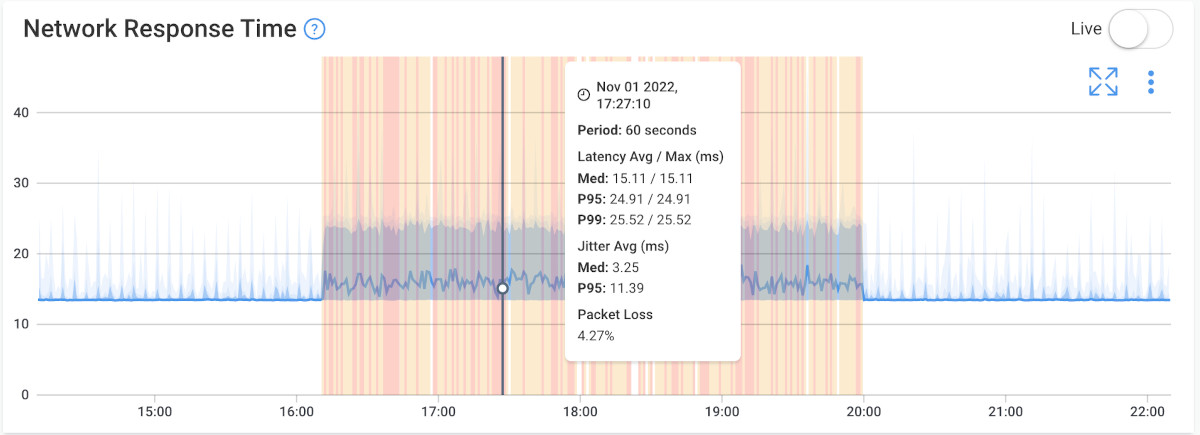
By monitoring these key network metrics proactively, you can identify potential issues before they become major problems and ensure that your network is performing optimally. You can also use these metrics to optimize your network performance and ensure that users have a positive experience accessing network resources.
Obkio continuously monitors network performance, but you don’t always have to be on the lookout.
That’s because Obkio allows you to set up automatic alerts that notify you, or any selected members of your team, whenever the software detects network issues anywhere in your network. It can also let you know of any network performance degradation at all, so you can act before a problem actually develops.
Automatic network monitoring alerts are a critical component of proactive network monitoring because they allow IT teams to quickly identify potential issues and take corrective action before they impact network performance or user experience.
- Real-Time Notifications: By setting up automatic alerts for key network metrics such as bandwidth utilization, latency, packet loss, and availability, IT teams can receive real-time notifications when these metrics exceed predetermined thresholds or deviate from expected levels. This allows them to quickly investigate and resolve potential issues before they become major problems, reducing downtime and minimizing the impact on users.
- Identify Security Threats: Automatic alerts also enable IT teams to proactively monitor network security and detect potential threats such as malware infections or unauthorized access attempts. By setting up alerts for suspicious network activity or unusual traffic patterns, IT teams can quickly identify and respond to potential threats, preventing data breaches and other security incidents.
- Detect Network Issues Fast: Automatic alerts can also help IT teams optimize network performance by identifying potential bottlenecks or capacity issues. By setting up alerts for network metrics such as throughput or bandwidth utilization, IT teams can identify potential performance issues and take corrective action before they impact user experience or business operations.

How do you start monitoring network performance? Well, you need to establish good performance from bad performance. Obkio collects performance history, allowing you to go back in time and establish a baseline of the network performance with a 1-minute granularity. You can also go back in time to troubleshoot past network issues.
Setting a network baseline and maintaining a history of network performance metrics is an important aspect of proactive network monitoring. By establishing a baseline, IT teams can define what normal network performance looks like and set thresholds for alerts when network metrics deviate from expected levels.
- Identify A Pattern: By capturing data on network metrics such as bandwidth utilization, latency, packet loss, and availability, IT teams can establish a historical record of network performance and identify patterns and trends in network behavior.
- Detect Changes in Performance: Maintaining a history of network performance metrics is also important for detecting changes in network behavior and identifying potential issues before they become major problems. By comparing current network performance metrics to historical data, IT teams can quickly identify when network metrics are deviating from expected levels and take corrective action before users are impacted.
- Plan for Future Changes: Furthermore, a historical record of network performance metrics can be used for network capacity planning and forecasting future network needs. By analyzing trends in network behavior over time, IT teams can identify areas of the network that may require additional network capacity or upgrades to support future growth.
Overall, setting a baseline and maintaining a history of network performance metrics is an essential component of proactive network monitoring. It enables IT teams to quickly identify and respond to potential issues, optimize network performance, and plan for future network needs.
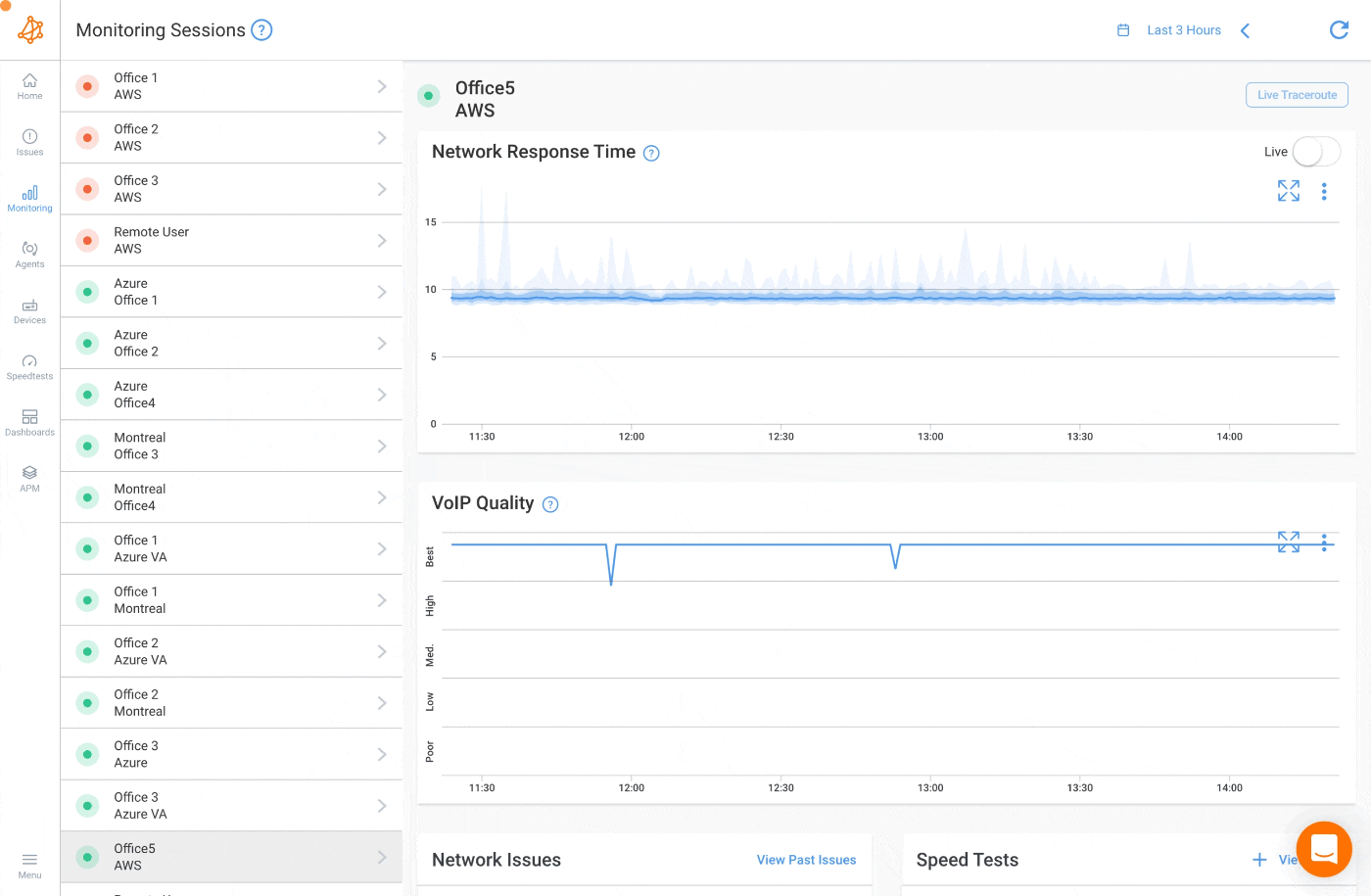
Some people may turn to proactive network monitoring in emergency situations to specifically identify network issues that may be plaguing their business.
So, they notice some network degradation or performance issues, and they need to perform a network assessment to find out what’s wrong, and then perform some network troubleshooting to pinpoint and solve these issues.
While many users of network monitoring software may discover the tool in an emergency situation, they soon realize that the real benefit comes with continuous and proactive network monitoring.
Proactive network monitoring can also play a role in monitoring the operational performance of applications. It can help companies establish a network performance baseline that can help them identify performance degradation, as well as serve as a comparison point for network optimization.
In summary, proactive network monitoring:
- Becomes a permanent installation for continuous monitoring for your business.
- Proactively discovers network issues and alerts those responsible for fixing them.
- Notifies the IT team of any network degradation whatsoever, before it becomes a real problem.
Proactive network monitoring is used to identify network issues before they impact network performance or user experience. IT teams use various techniques and tools to collect and analyze network performance metrics, such as bandwidth utilization, latency, packet loss, and availability, in real-time or near real-time.
By monitoring these metrics over time, IT teams can establish a baseline for normal network behavior and set thresholds for alerts when network metrics deviate from expected levels. This enables IT teams to detect potential issues before they become major problems and take corrective action to prevent network downtime or degradation in performance.
For example, if IT teams observe a sudden increase in bandwidth utilization or a spike in latency, they can investigate the cause of these issues and take appropriate action to alleviate the problem. They may discover that a particular application is consuming excessive bandwidth or that a network device is malfunctioning and causing latency issues.
Similarly, by monitoring network security metrics such as traffic patterns and anomalies, IT teams can detect potential security threats such as malware infections or unauthorized access attempts. This enables IT teams to take prompt action to prevent data breaches or other security incidents.
Picture this: it's Monday morning and your team is gearing up for a busy week ahead. You're the network administrator and you've just finished your morning coffee when you receive an alert that your network bandwidth utilization has spiked to 90% capacity. Your heart rate quickens as you imagine the chaos that could ensue if the network goes down. But wait, there's no need to panic!
Thanks to your proactive network monitoring strategy, you're able to quickly identify and resolve the issue before it causes any major disruptions. Here's how it all went down.
A company relies heavily on its network to support day-to-day operations. However, the network bandwidth utilization has been increasing steadily over the past few weeks, and the network administrator is concerned that the network could reach capacity soon. The network administrator needs to identify the root cause of the issue and take corrective action before it impacts network performance or user experience.
To address the network bandwidth utilization issue, the company implements Obkio, a proactive network monitoring tool that provides real-time visibility into network performance metrics. Obkio allows the company to monitor bandwidth utilization in real-time, set thresholds for alerts when utilization exceeds a certain level, and analyze historical data to identify trends and patterns in network behavior.
When the network administrator receives an alert from Obkio that the network bandwidth utilization has spiked to 90% capacity, they use Obkio's analytics and visualization tools to quickly identify the root cause of the issue.
They discover that a particular application is consuming excessive bandwidth and causing the spike in utilization. The network administrator takes corrective action by implementing Quality of Service (QoS) policies to prioritize critical network traffic and limit the bandwidth used by non-critical applications.
Thanks to Obkio's proactive network monitoring capabilities, the company is able to identify and resolve the issue before it impacts network performance or user experience. By implementing QoS policies to prioritize critical network traffic (such as Qos or QoS for VoIP) and limit the bandwidth used by non-critical applications, the company is able to ensure that essential network traffic is not impacted by excessive bandwidth utilization.
This results in improved network performance, reduced downtime, and increased productivity for the company. Yay!
Congratulations! You're now a proactive network monitoring pro. But before we wrap up this article, let's review some best practices to help you stay ahead of the game. In this section, we'll summarize our key takeaways and provide you with some actionable tips to optimize your proactive network monitoring strategy. So let's dive in!
- Establish a baseline: Before implementing any proactive network monitoring strategy, establish a baseline for network performance metrics such as bandwidth utilization, latency, and packet loss. This baseline will help you to identify any significant deviations from normal network behavior.
- Set thresholds and alerts: Set thresholds for network performance metrics and configure automatic alerts when thresholds are exceeded. This will allow you to proactively identify and resolve issues before they impact network performance or user experience.
- Use synthetic testing: Synthetic testing is a technique that simulates network traffic to test network performance and identify potential issues before they occur. Use synthetic testing regularly to identify issues before they impact users.
- Monitor end-to-end performance: It's important to monitor the end-to-end performance of the network, including servers, applications, and end-user devices. This will help you to identify the root cause of network issues and take corrective action.
- Analyze historical data: Use historical data to identify trends and patterns in network behavior. This will help you to anticipate and proactively address issues before they occur.
- Utilize automation: Use automation tools to streamline network monitoring tasks, such as configuring alerts and analyzing network performance metrics. This will allow you to focus on more complex issues and reduce the likelihood of human error.
- Regularly review and update your monitoring strategy: Network environments are constantly evolving, so it's important to regularly review and update your proactive network monitoring strategy to ensure that it remains effective.
By following these network monitoring best practices for proactive network monitoring, you can ensure that your network is running smoothly and proactively address any issues before they impact network performance or user experience.

And that's a wrap! We hope you've enjoyed this article on proactive network monitoring and learned something new. Remember, the key to successful network monitoring is to stay ahead of the game. By adopting a proactive approach and implementing the best practices we've outlined, you can ensure that your network is running smoothly and that any potential issues are identified and resolved before they impact user experience.
Remember, proactivity leads to productivity, and when it comes to optimizing network performance, you need to be productive to keep monitoring, keep fixing, and keep optimizing.
And don't forget, using a tool like Obkio makes it even easier to implement a proactive network monitoring strategy!
- 14-day free trial of all premium features
- Deploy in just 10 minutes
- Monitor performance in all key network locations
- Measure real-time network metrics
- Identify and troubleshoot live network problems
So, what are you waiting for? Start monitoring proactively today and keep your network running like a well-oiled machine!













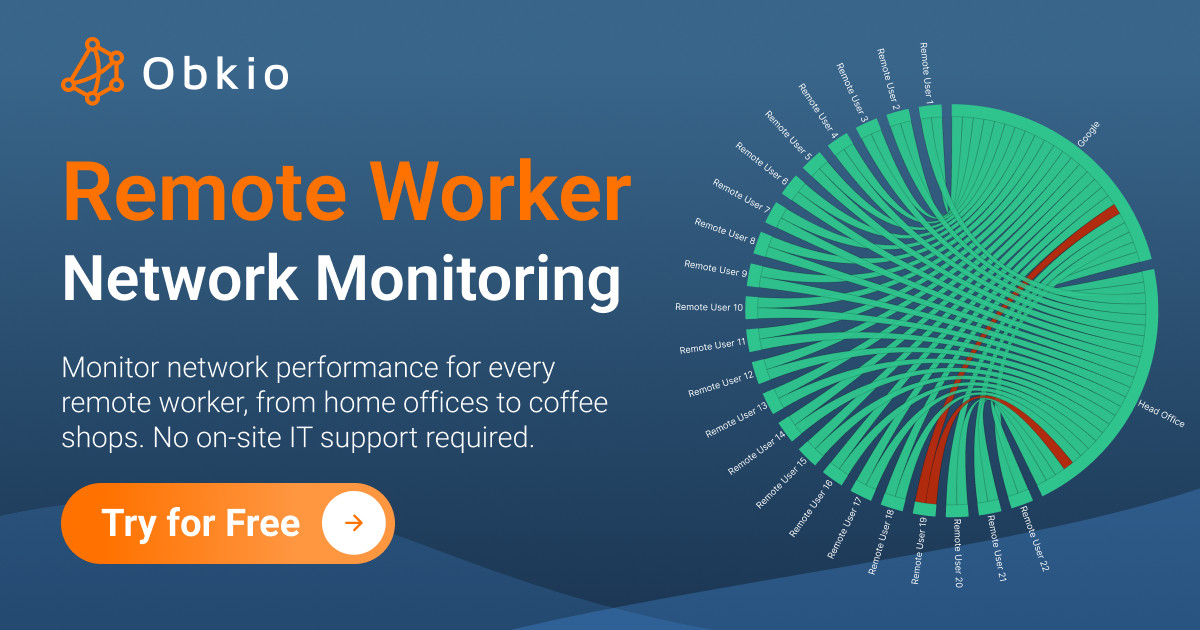













 Obkio Blog
Obkio Blog







